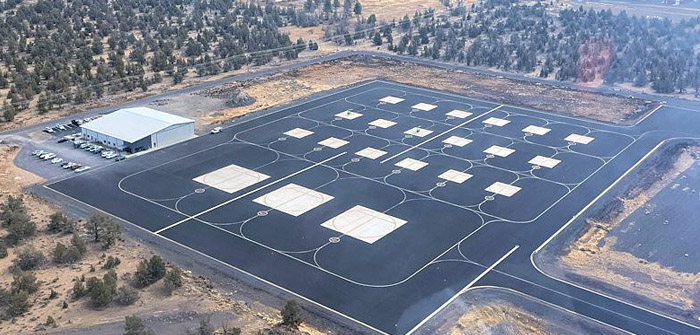(A separate eight-acre heliport operations area opened up 500,000 square feet of developable land | Photo courtesy of Bend Municipal Airport)
“I’m passionate about what I do,” said Tracy Williams, general manager of the Bend Municipal Airport, “and take pride in making a difference for the communities I serve” — attributes she is putting to good use in obtaining the facility’s number one safety improvement priority: an air traffic control tower.
An accredited airport executive for 30-plus years, Williams explained that despite being Oregon’s third busiest airport in terms of aircraft takeoffs and landings — with 140k annually, or 380 a day — Bend’s facility still operates in an “uncontrolled airport” environment.
Currently, pilots manage themselves by communicating with one another on the Common Traffic Advisory Frequency (CTAF). “This is particularly challenging,” said Williams, “when winds suddenly change, and for a brief time there is opposite-direction traffic operating on the single 5,260-foot runway until pilots are able to safely reposition themselves.” But, she added, “there is no requirement to communicate on the CTAF. While most pilots state their intentions, some don’t. We have been fortunate.”
Getting an air traffic control tower “is all about safety, safety, safety in terms of separation of aircraft, the complex regional airspace, and the local environment,” Wilson said. “A tower will ‘deconflict’ our current situation, ensuring operators are appropriately sequencing, both in landings and takeoffs.”
A 2019 survey identified having an air control tower as the number one priority among Bend Airport stakeholders in terms of facility improvements and the City of Bend — which has owned and operated the airport since the end of World War II, when it was used for pilot training — has ranked the project “among the top of competing priorities on its list,” said Williams.
Of the $15M total cost estimate to make the air traffic control tower a reality, an initial grant allocation of approximately $200k funded a site selection study and environmental assessment, while $1.6M for design has been received and executed (with completion expected in March 2024). The latter amount came from the Bipartisan Infrastructure Law, with Sens. Ron Wyden and Jeff Merkley, D-Ore., commenting that construction of a permanent control tower “will help ensure the region has the critical infrastructure necessary to support and promote air travel for Oregon businesses, travelers, and tourists.”
The State of Oregon has contributed $4.875M; and Williams secured an in-person commitment of an additional $6M from Congresswoman Lori Chavez-DeRemer, R-Ore., a member of the Transportation and Infrastructure Committee, (which falls under Transportation, Housing and Urban Development). In addition, the FAA has programmed $4M in discretionary spending. Taken together, these amounts represent “a commitment to ensure all or most of the needed funding — with plans to pursue additional grant opportunities as they are made available,” Williams said.
Under her tenure, Bend Municipal Airport has gone from being subsidized by general fund taxpayer dollars to becoming self-sufficient “as an enterprise user fund.” In addition, Williams said, the facility’s regional economic impact is significant, as reported by the Oregon Department of Aviation: 860 jobs), $166M in sales (direct, indirect, and induced), a $32M payroll, $6M in general aviation spending, and $4M in construction.
The airport, which caters to the needs of general aviation and business users, is home to approximately 300 aircraft and 18-plus aviation-related businesses, as well as a separate eight-acre helicopter operations area that opened up 500,000 square feet of developable land in 2017.
Taking advantage of this opportunity, Leading Edge Flight Academy just expanded its on-site school with construction of helicopter operations hangar, making use of the airport’s heliport with its capacity of 21 helicopter parking spaces. In the words of CEO Brad Fraley, this “will ensure a safe training environment for our pilots, students, and commercial operations. We are truly excited for our future.”
But there’s more. According to Williams, 50 individual hangars have gone up, or are under various stages of construction, since she was hired three-plus years ago.
A U.S. Air Force veteran, Williams was only five years old when she first visited an airport with her father, leading her to tell him “Daddy, when I grow up, I want to be a pilot.” It comes as no surprise that Williams subsequently obtained her pilot’s license, as well as an M.A.S. in aeronautics, and served on active duty during Operation Desert Storm. She then moved into the role of airport executive at locations across the United States before applying her expertise locally.
Bend Municipal Airport by the Numbers:
- Total size of approximately 420 acres
- 60 acres available for development
- 2.8 million square feet of ground leased space
- 2.6 million square feet of leasable space
- 78 City-owned leased hangar spaces totaling 139,000 square feet 58,000 square feet of aircraft and vehicle parking
bendoregon.gov/government/departments/economic-development/bend-airport




